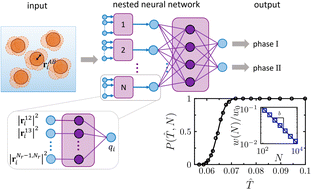Machine learning glass caging order parameters with an artificial nested neural network†
Abstract
Around a glass transition, the dynamics of a supercooled liquid dramatically slow down, exhibited by caging of particles, while the structural changes remain subtle. Alternative to recent machine learning studies searching for structural predictors of glassy dynamics, here we propose to learn directly particle caging features defined purely according to dynamics. We focus on three transitions in a simulated hard sphere glass model, the melting of ultra-stable glasses, the Gardner transition and the liquid to ordinary glass transition. Implementing the machine learning algorithm based on a two-level nested neural network, we attain not only appropriate caging order parameters for all three transitions, but also a phase classification for input samples. A finite-size scaling analysis of the phase classification results identifies the order of melting (first) and Gardner (second) transitions. A false positive is avoided, as the liquid to glass transition is indicated as a crossover, rather than a phase transition with a well-defined transition point. This study paves the way to a generic approach for learning dynamical features in glassy systems, with a minimum requirement of system-specific knowledge.



 Please wait while we load your content...
Please wait while we load your content...